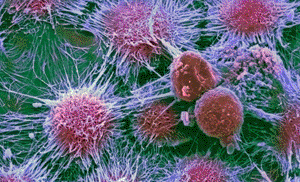New Class of Chemotherapeutic Drugs Targets the Warburg Effect
By LabMedica International staff writers
Posted on 16 Aug 2011
A new approach to cancer chemotherapy takes advantage of the Warburg effect, a metabolic phenomenon that occurs in tumors but not in normal tissues.Posted on 16 Aug 2011
The Warburg effect is the observation that most cancer cells predominantly produce energy by a high rate of glycolysis followed by lactic acid fermentation in the cytosol, rather than by a comparatively low rate of glycolysis followed by oxidation of pyruvate in mitochondria like most normal cells. Malignant rapidly growing tumor cells typically have glycolytic rates that are up to 200 times higher than those of their normal tissues of origin do; this occurs even if oxygen is plentiful.

Image: Colored scanning electron micrograph (SEM) of cancer cells (pink) from a kidney tumor (Photo courtesy of David McCarthy / SPL).
Investigators at Stanford University (Palo Alto, CA, USA) searched for candidate drugs to target the Warburg effect the drives cancer cell growth and proliferation. To this end, they used high-throughput screening techniques to evaluate a library of 64,000 synthetic chemical compounds for the ability to block the Warburg effect and cause the death of renal cell carcinoma (RCC) tumor cells. About 80% of RCCs have a mutation that causes the loss of the von Hippel–Lindau (VHL) tumor suppressor gene, which contributes to their dependence on the Warburg effect.
The investigators reported in the August 3, 2011, online edition of the journal Science Translational Medicine that they had identified a class of compounds, the 3-series, exemplified by STF-31, which selectively killed RCCs by specifically targeting glucose uptake through inhibition of the protein glucose transporter 1 (GLUT1) and exploiting the unique dependence of these cells on GLUT1 for survival.
In a mouse kidney-cancer model, STF-31 nearly halved the amount of glucose imported by tumors and slowed tumor growth. In mice, the drug appeared to have few side effects, and animals treated with the compound for 14 days had no apparent damage to their normal tissues. The mice maintained a normal immune system and normal numbers of blood cells.
“This study demonstrates an approach for selectively inhibiting the ability of cancer cells to take up glucose, which is a pretty powerful way of killing those cells,” said senior author Dr. Amato Giaccia, professor of radiation oncology at Stanford University. “Most normal tissues in the body do not possess this mutation, so a drug that targets this vulnerability should be very specific for cancer cells.”
Related Links:
Stanford University













